1 Day Bangkok Cultural Itinerary – Palace, Temples, Canal Boat Ride & Floating Market
Due to my tight schedule in Bangkok, I cobbled an itinerary that captures the main sights of Bangkok without having the feeling that you are being rushed around to check things off a list. So if you are looking to have a family or children friendly itinerary, you may want to include some of these places into your list of places to visit.
This itinerary is ideal as the sites are right beside each other and can be done in 2.5 to 3.5 hours (for the Grand Palace and the Temples) and another 1.5 hours (for the Boat Ride and Floating Market).
The Grand Palace and the surrounding temples of Wat Pho and Wat Phra Kaew
If you look through the online guides and various printed guidebooks, you will soon realise that Bangkok is all about … temples! If you see the word “Wat”, it is a give away that you are dealing with a temple. To prevent yourself from overloading on temples during your trip, I suggest you hit Wat Pho together with the Grand Palace (that is inclusive of Wat Phra Kaew) and if you are still interested in exploring the other Wats, you can do so on another day. If you are done with exploring temples, you at least could tell your friends back home you saw the top two temples in Bangkok and how amazing they looked.
Wat Pho, first!
My suggestion is to hit Wat Pho first. While Wat Pho closes much later (6.30pm) than the Grand Palace (3.30pm), this shouldn’t really matter as I am assuming you are starting the itinerary early in the morning. However, if you are starting in the afternoon, feel free to flip it around (this may, however, affect the second half of this itinerary which involves a boat ride).
The reason why I suggest hitting Wat Pho first is lighting. While Wat Pho may look impressive, the Grand Palace’s Wat Phra Kaew is even better. For those wanting that awesome selfie of the exotic east or an instagram worthy photo, your photos taken in the Grand Palace will look more vibrant when the Sun is fully up.
Wat Pho is the shortened form of the temple’s previous name, Wat Photaram. The temple is known for its Reclining Buddha that is 43m long and 15m high making it one of the largest in Thailand:
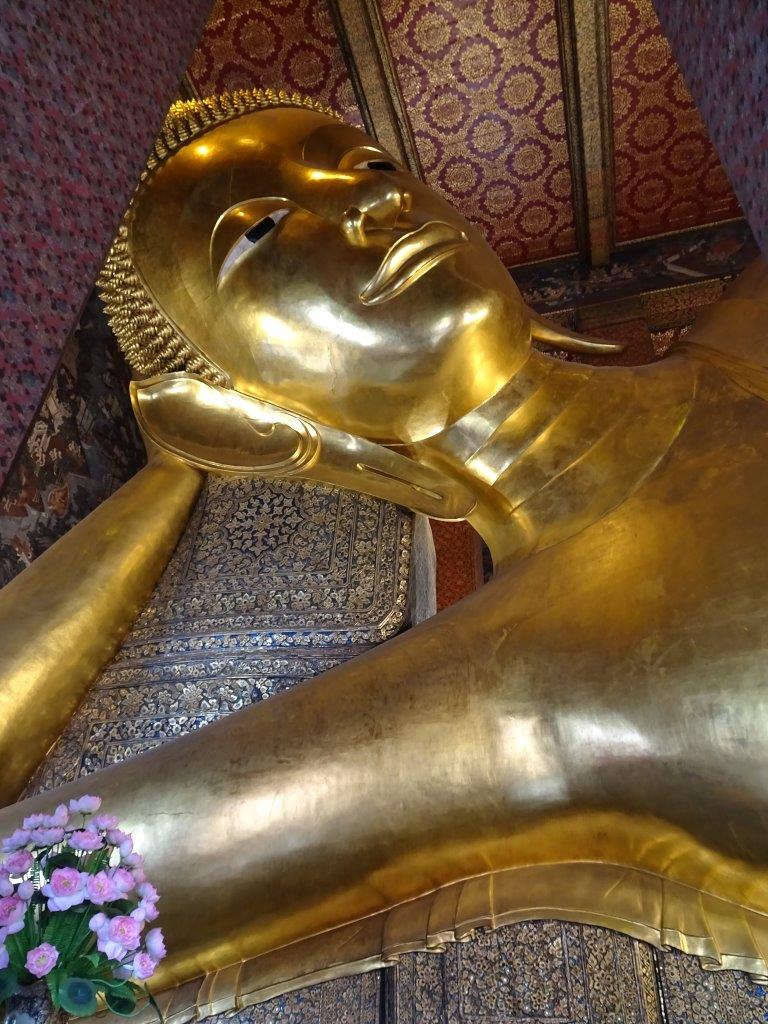
The temple has a long history having been rebuilt by King Rama I and later expanded by Rama III. The importance of Rama III is perhaps most evident from two empty stone tablets in the temple complex. Originally intended to record Rama III’s deeds, these tablets were left empty after the King died:
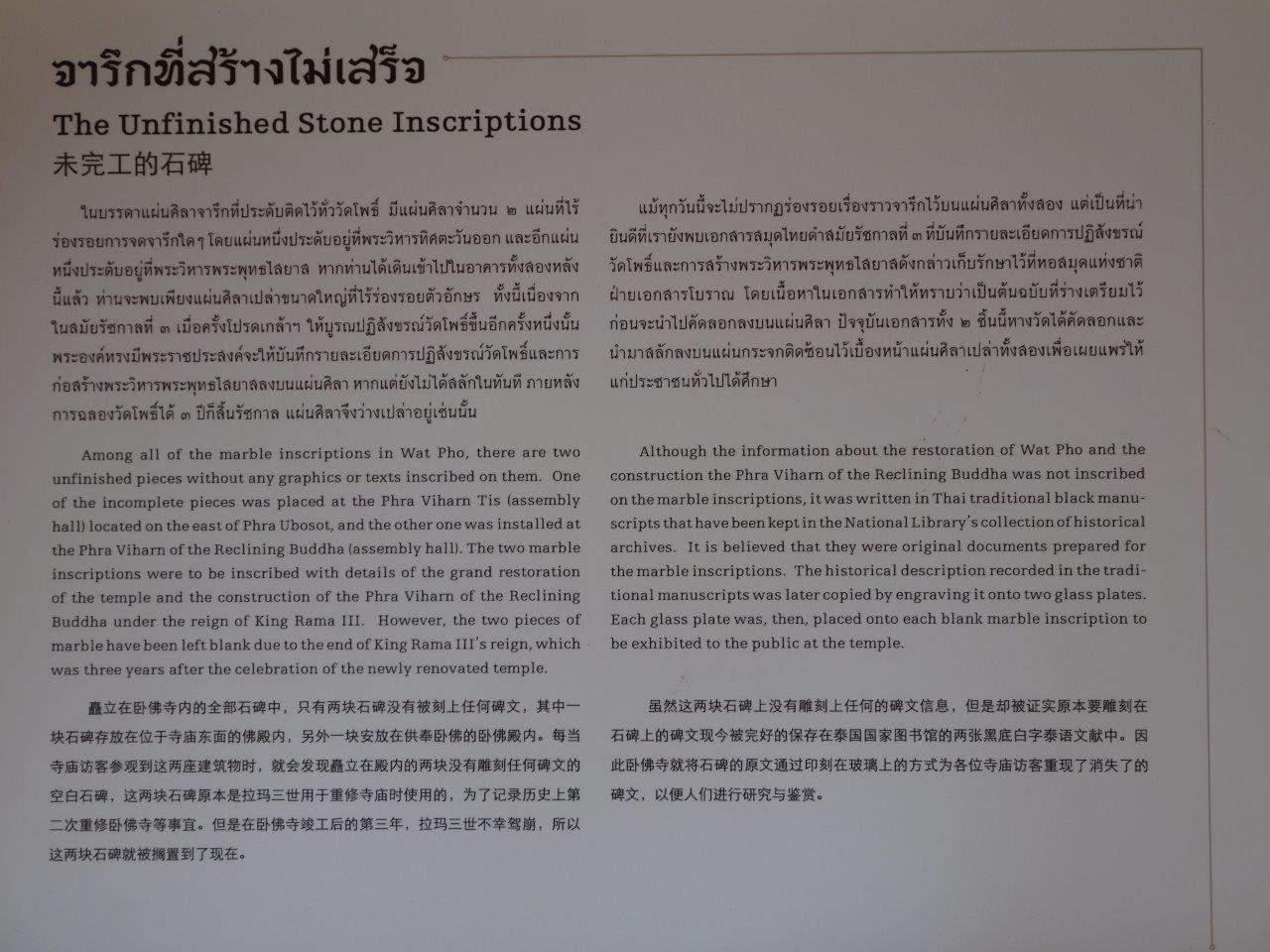
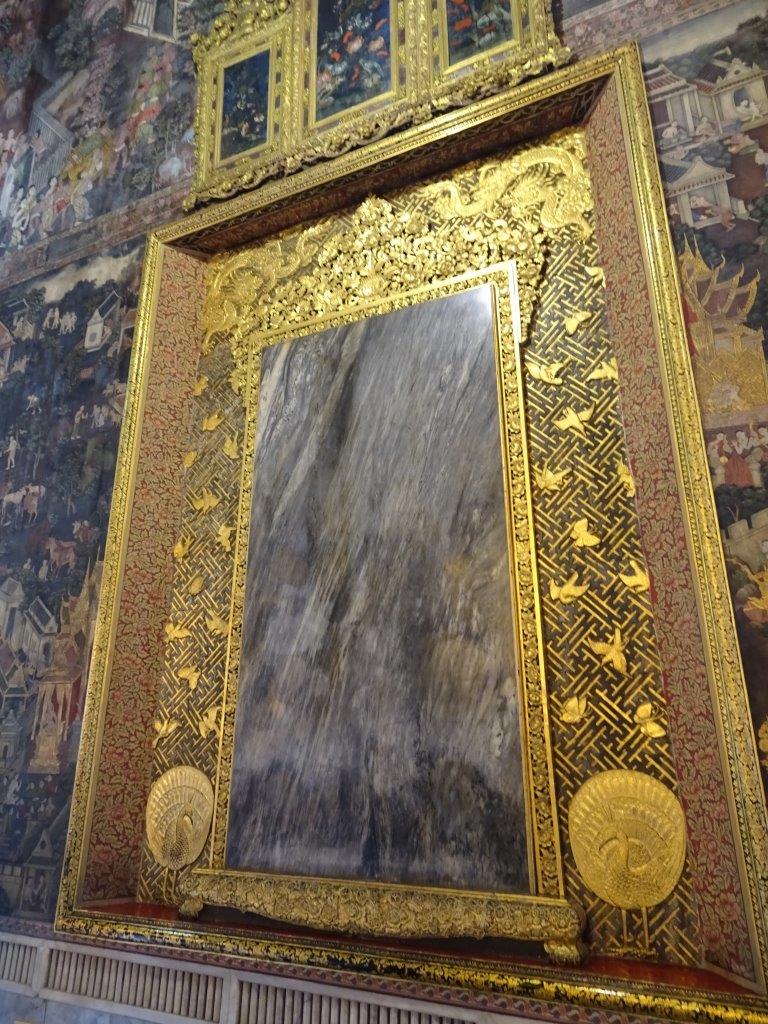
While the main highlight of this temple is the reclining buddha, be sure to look out for
- the beautiful architecture that is peculiar to this part of South East Asia;
- the rows of Buddhas lining the perimeter of the complex all facing the main building in its center also housing an impressive array of Buddha statues;
- the little “desks” with their iconic green lamps that help shed light on the complex’s history: and
- the gold leaf covered Buddhas.
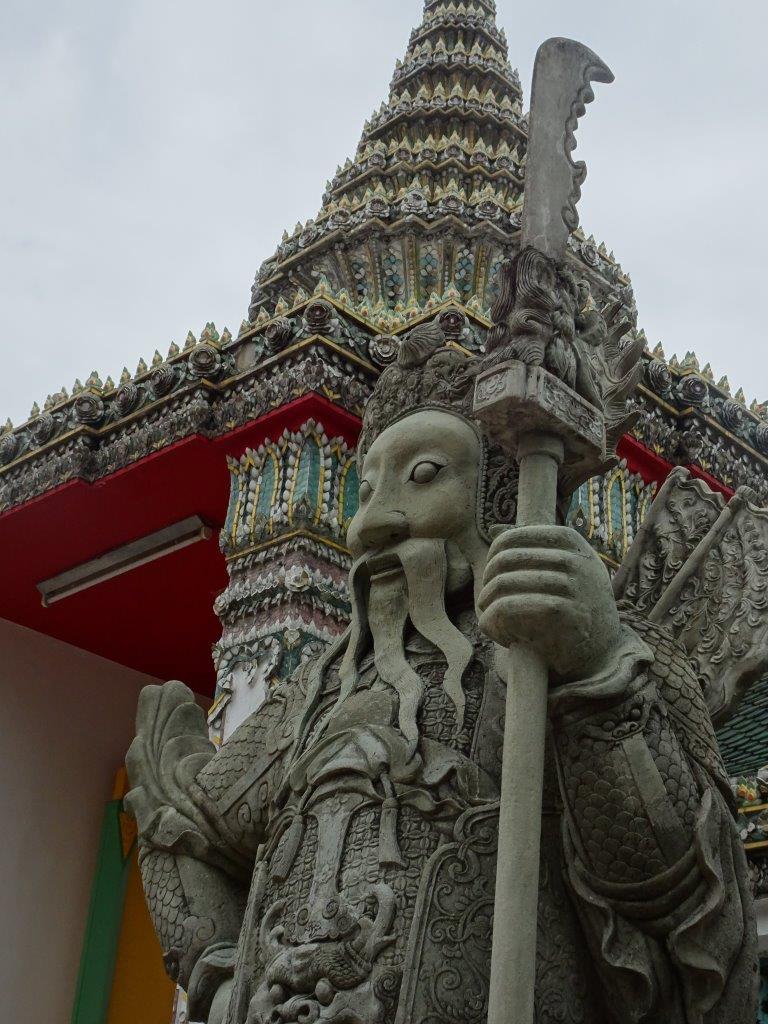
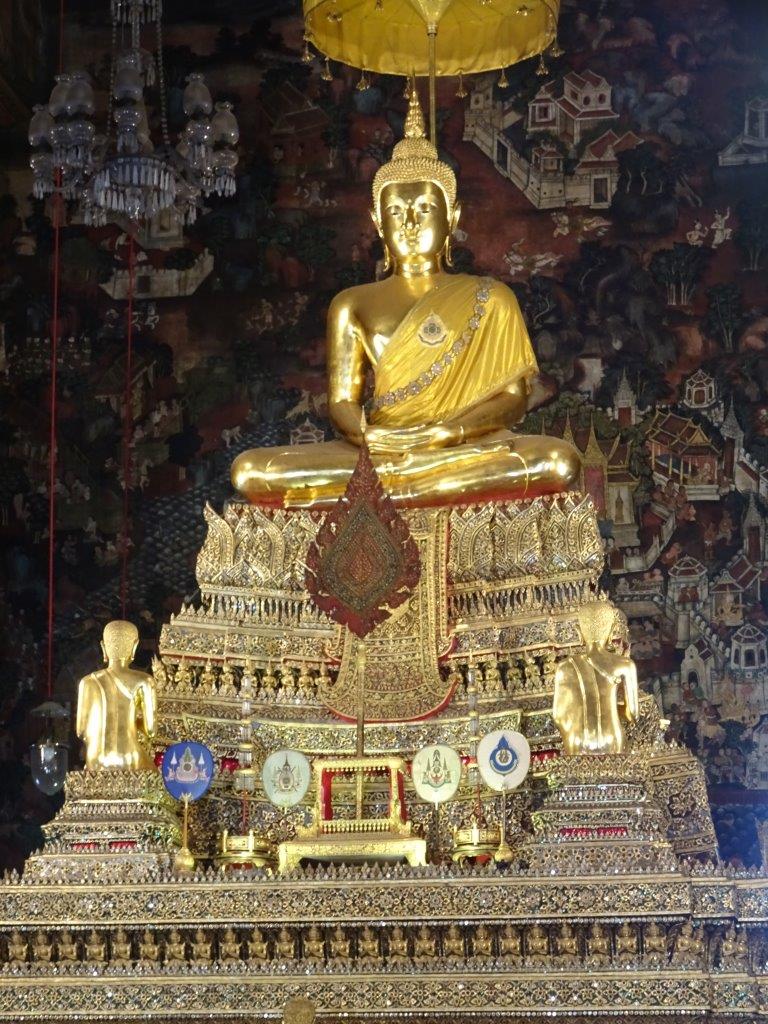
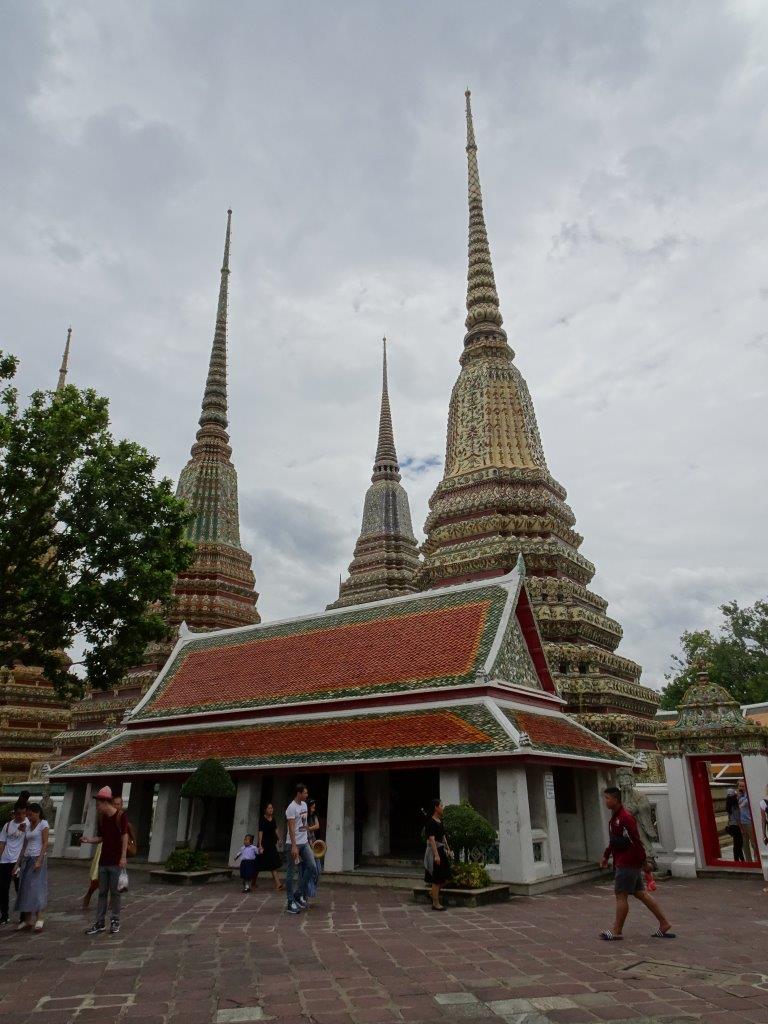
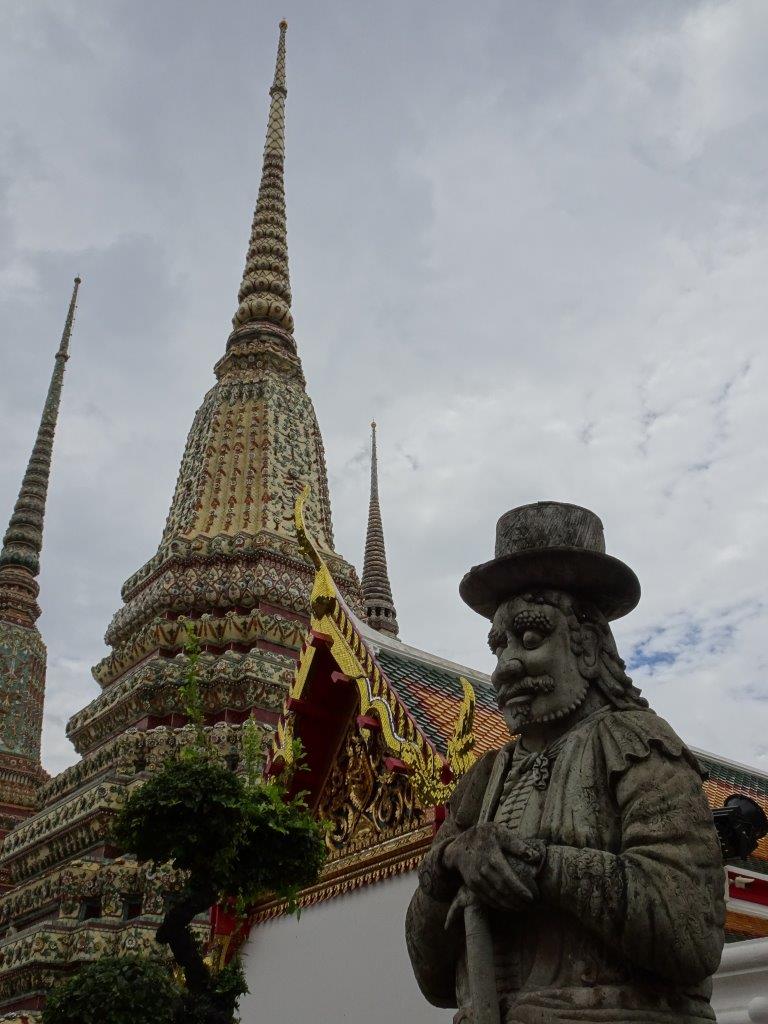
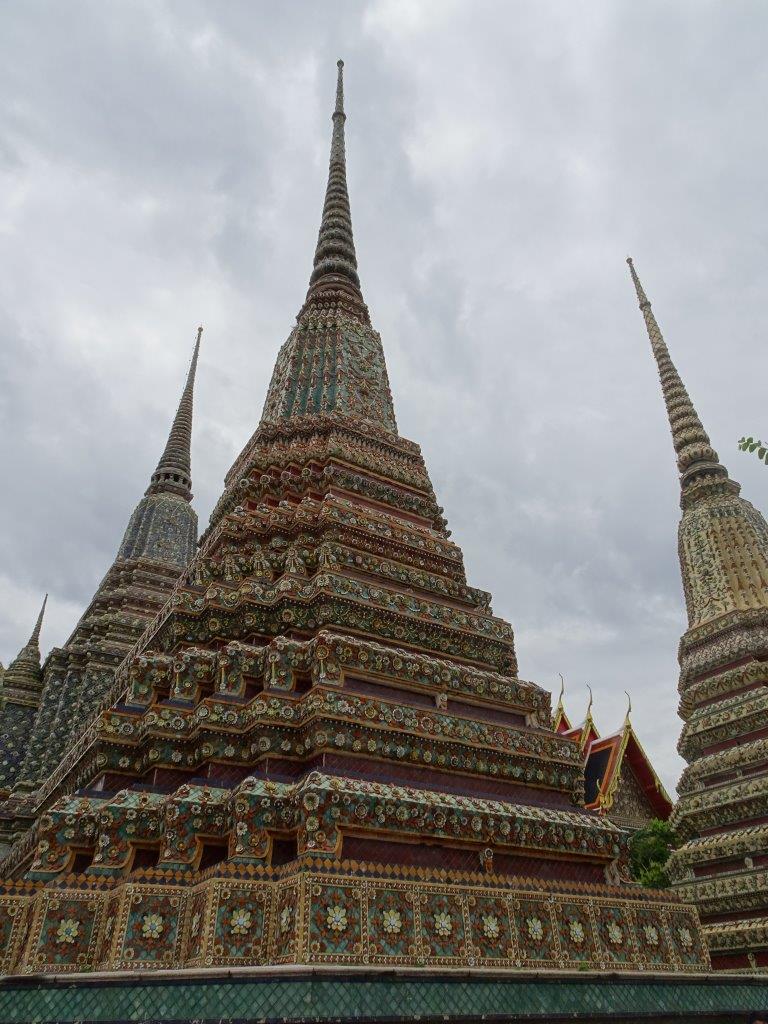
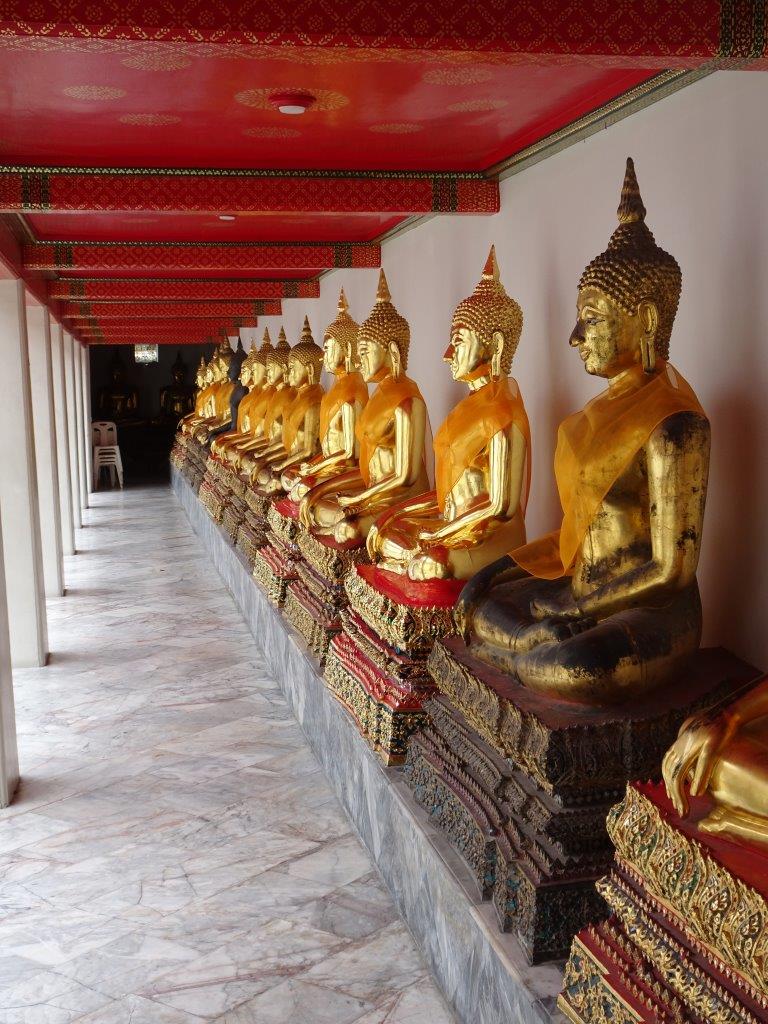
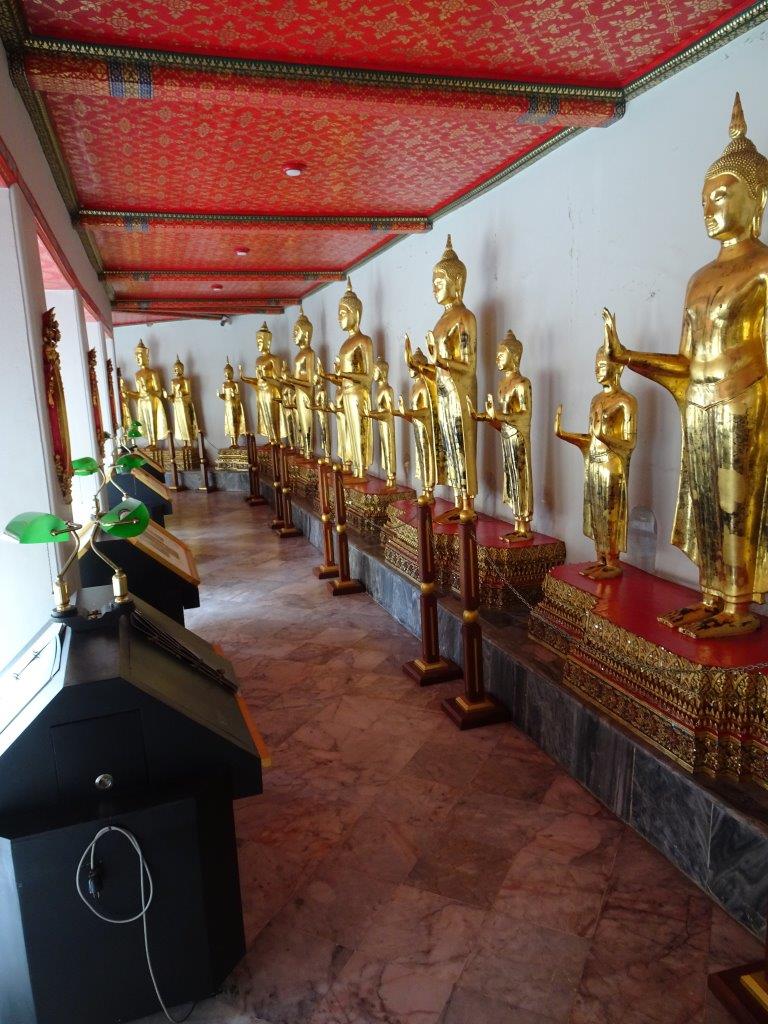
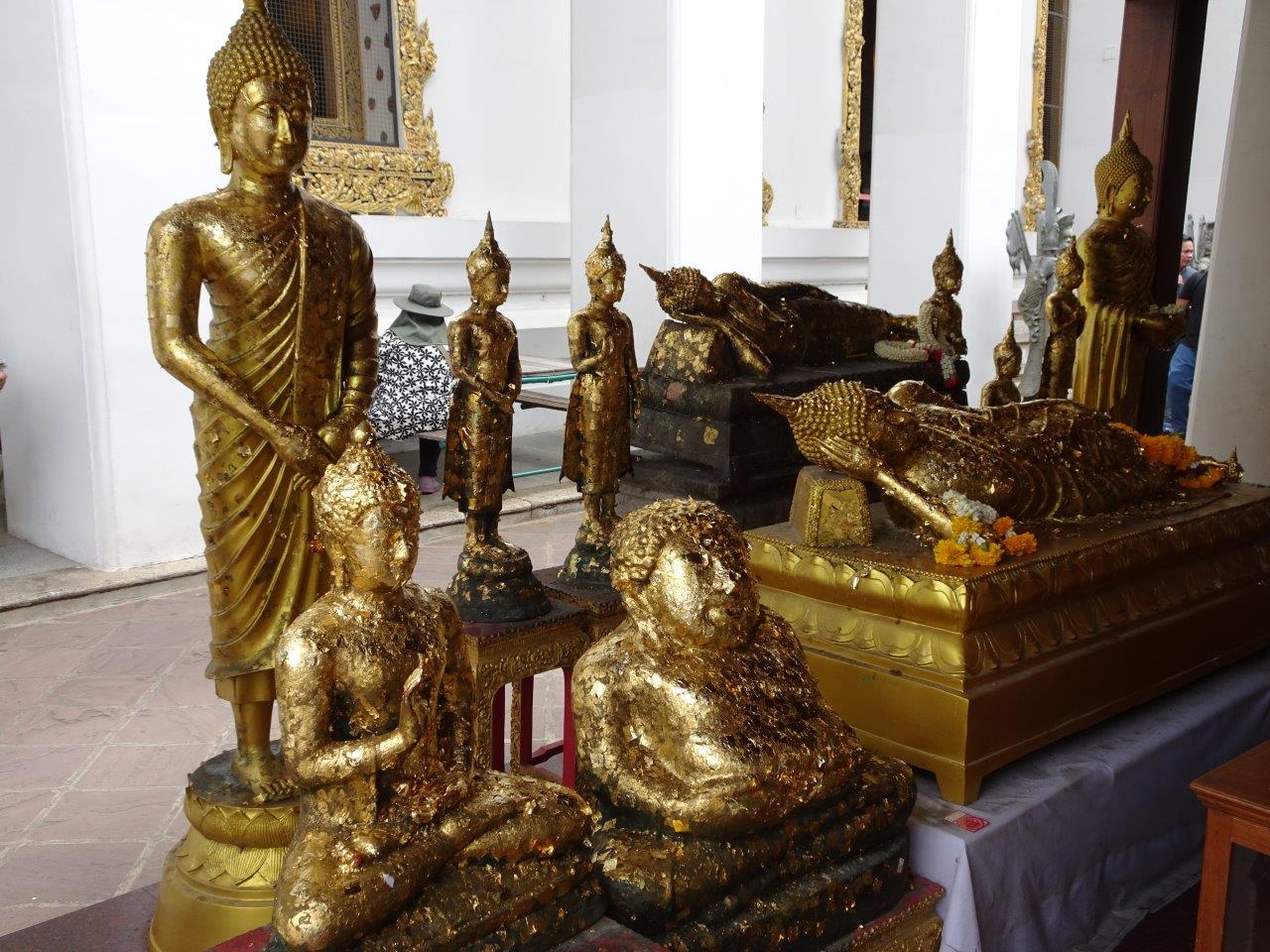
The entrance fee is 100 Thai Baht and comes with a free bottle of water. So if you want to cut back on weight, leave that bottle of yours at the hotel and get the free bottle with your ticket. There are refill points in the temple complex which you can use to top up your bottle before leaving the complex.
Grand Palace
There is an exit right beside the area where the reclining buddha is. This exit faces the rear of the Grand Palace. Once you leave Wat Pho, turn right and walk along the road. The wall of the Grand Palace should be on your left and Wat Pho on your right.
Keep walking.
At the time of my visit, Thailand is still in a national state of mourning. While the Grand Palace is open to tourists, you will likely find Thais as well dressed in black paying their respect to their deceased King. Given the numbers, security is tight. You will find a security check point at the end of the road. Go through it.
When in doubt, follow the other tourists in front of you. You will walk past the Thai ministry of defence with its decorative antique cannons before turning left towards the main entrance of the Palace:
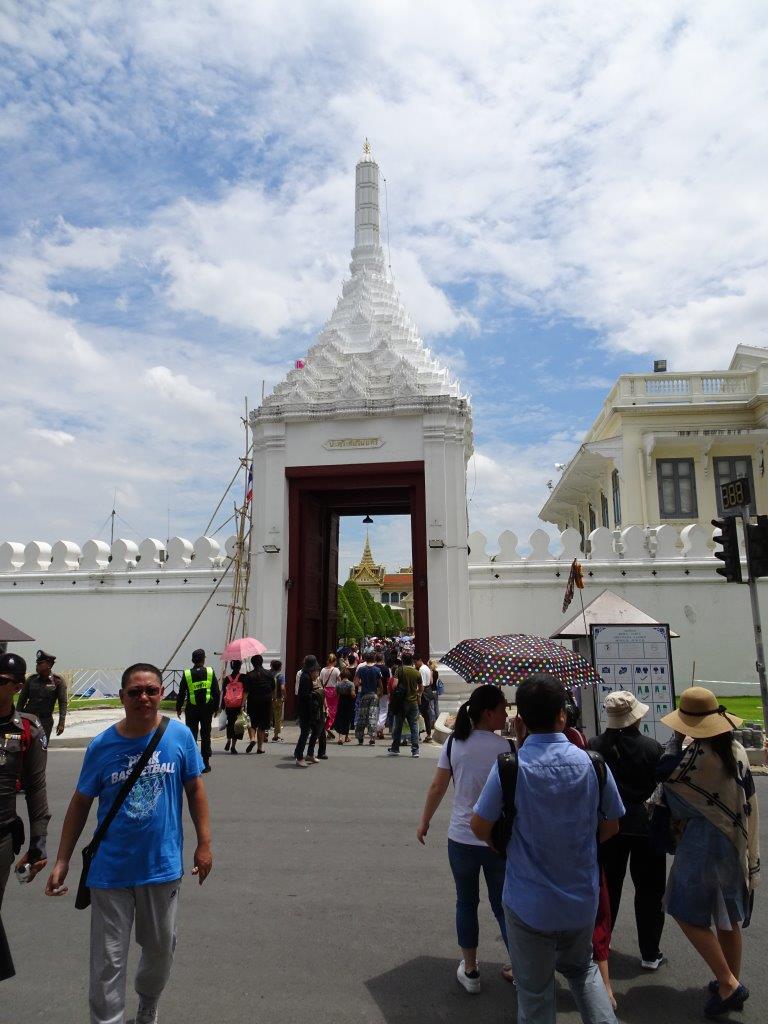
Once you enter the Palace, don’t worry of not seeing a ticket booth. Just follow the flow and the directions as the booth is located deeper inside the Palace.
The ticket costs 500 Baht and includes not only the entrance to the Wat Phra Kaew, the Grand Palace grounds and also other minor attractions. Depending on your time schedules, you may or may not want to visit these other minor attractions.
You will find an audio guide booth beside the ticket booth. They accept credit cards and passports as a security deposit. They do not accept national ID cards. As to whether to get a guide, again it depends on your preferences. If you want to know more, why not rent a guide? If you just want some flavour and context, there will be a pamphlet in various languages available once you walk into the paid area and past the murals on the wall:
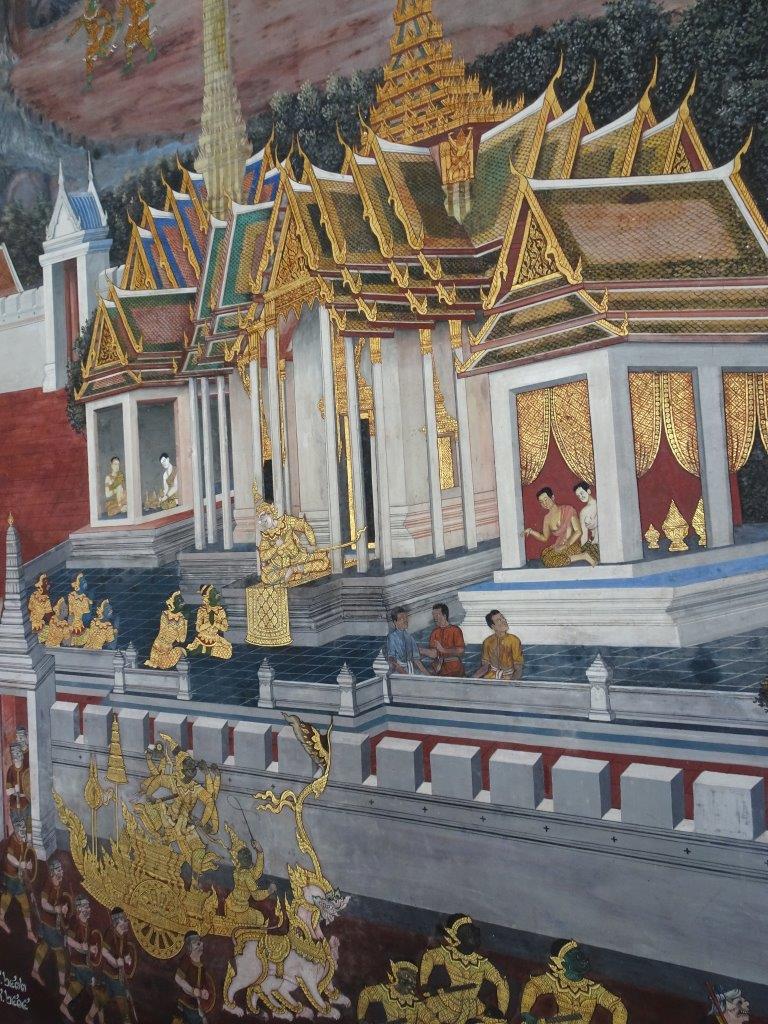
For me, the pamphlet was sufficient. I normally don’t remember much anyway (as its an overflow of information) so having bite size bits of information was enough.
Once you picked up your pamphlet, you will be dropped right smack into courtyard outside of Wat Phra Kaew (i.e. one part of the Grand Palace). For me, it felt like a sensory overload grander in scale than the sights in Wat Pho:
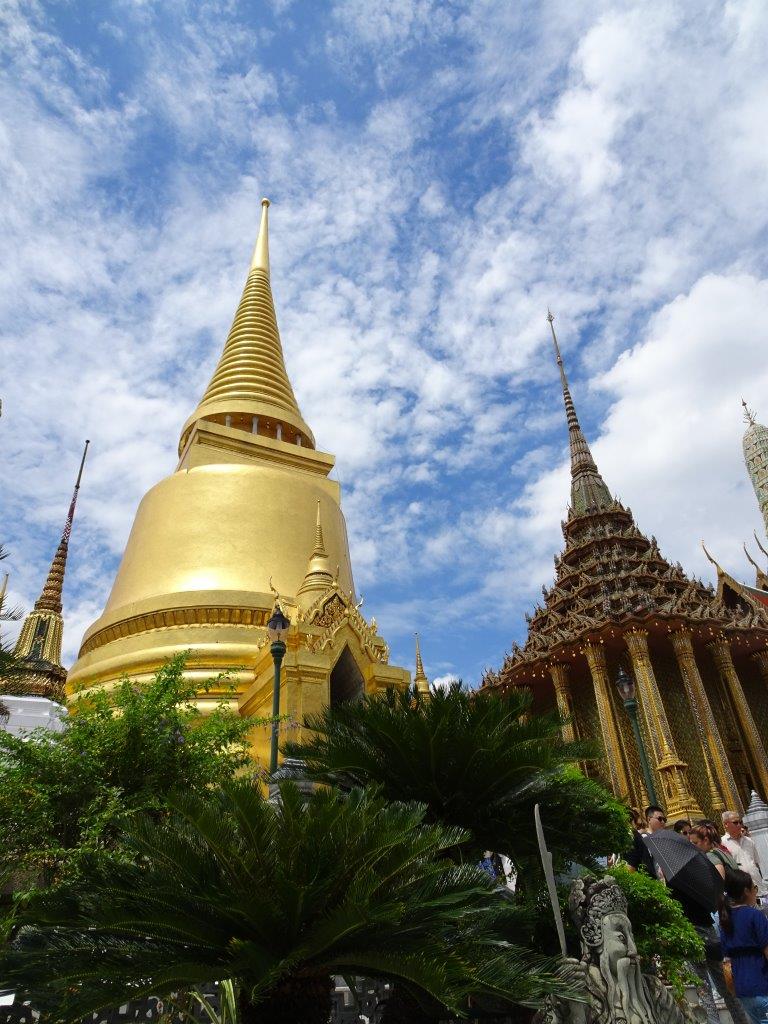
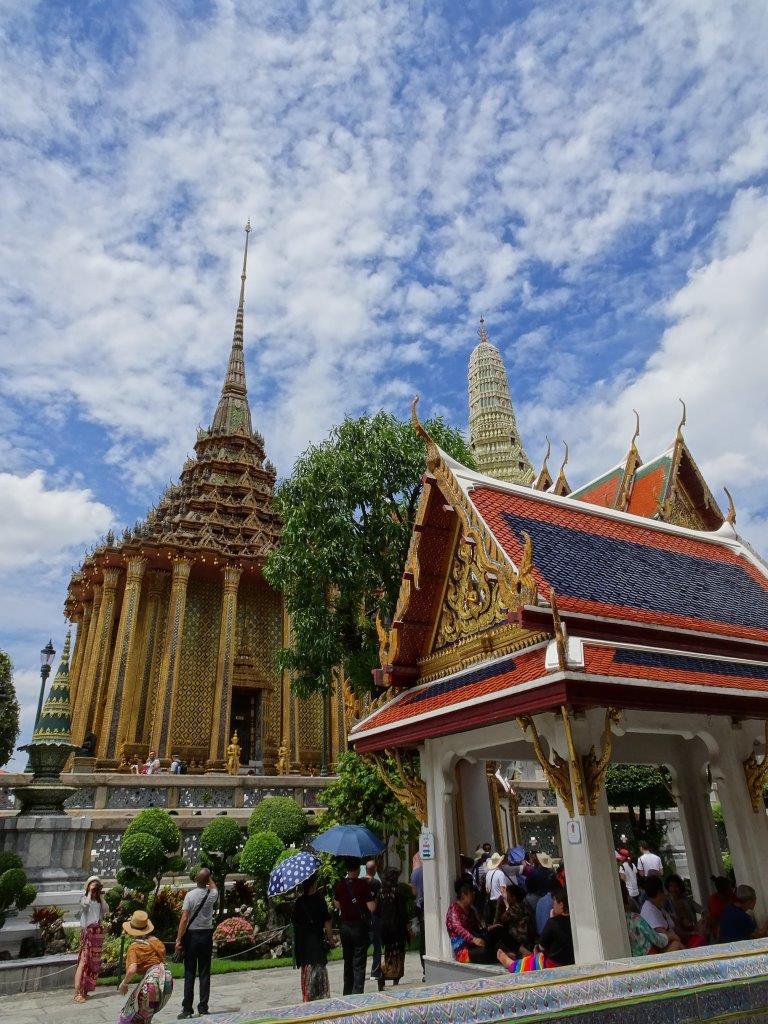

Follow the crowd and you will slowly move towards the heart of building housing the Emerald Buddha. The temple building itself is a work of art with intricate carvings and an overall beautiful facade:
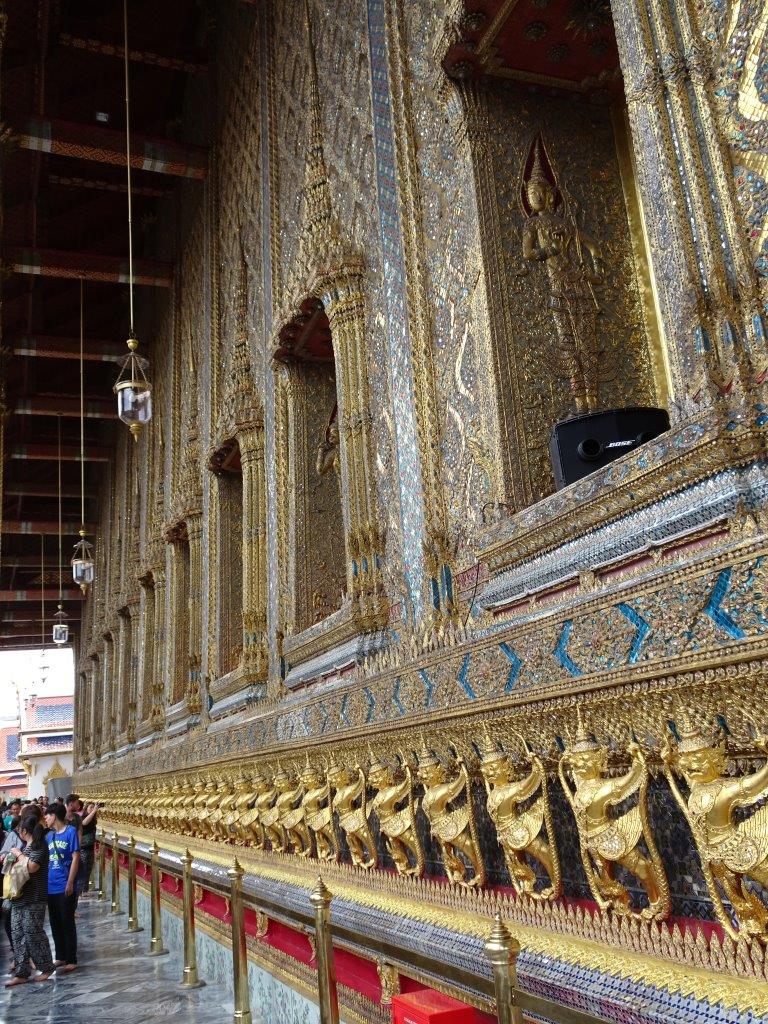
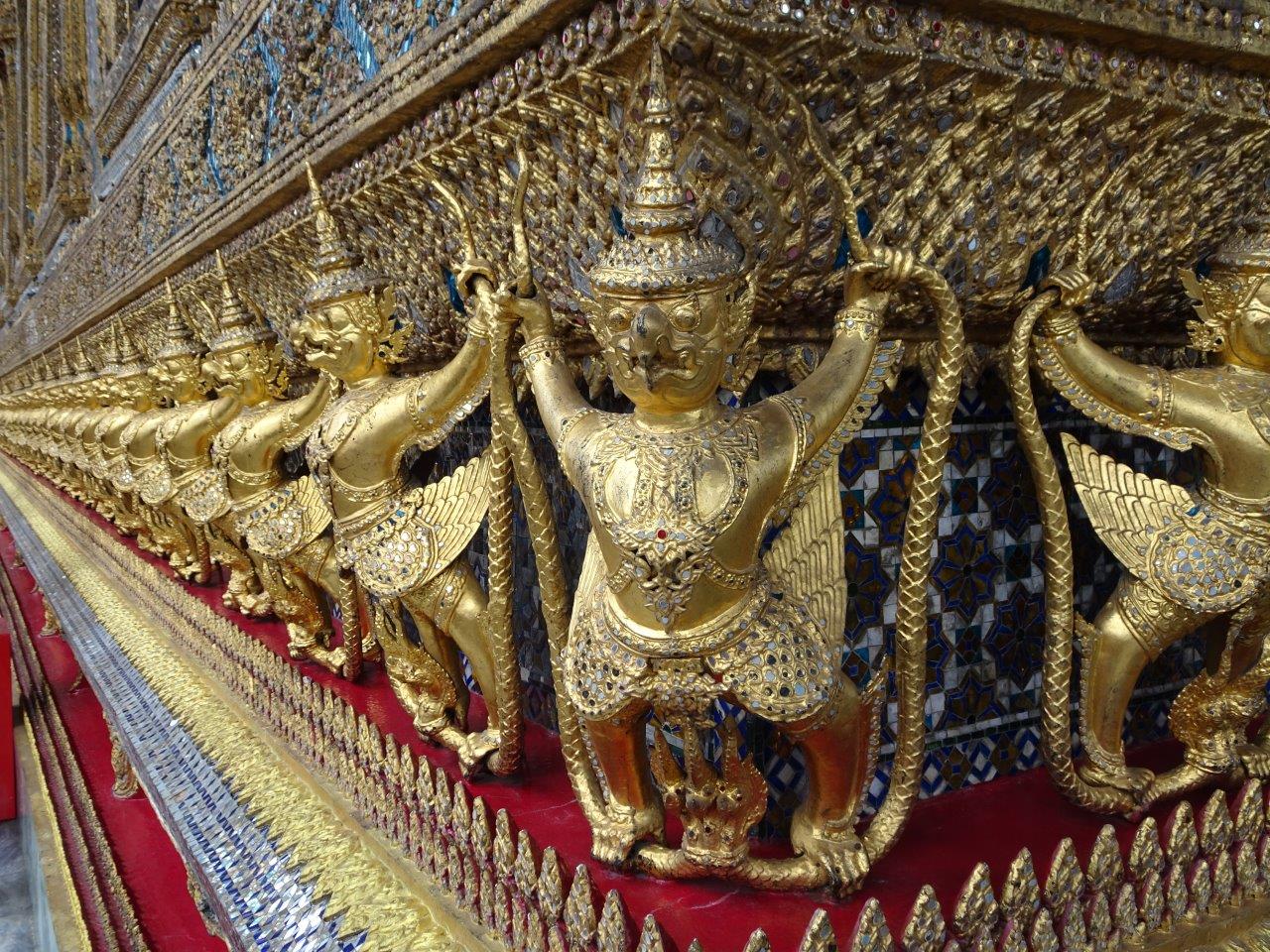
While I’m no history expert, Wikipedia has a short paragraph explaining the historical bit concerning the Emerald Buddha (which is actually jade and not emerald):
“It is not known when the statue of the Emerald Buddha was made, but it is generally believed that it was crafted in 14th-century Thailand. However, there are also claims that the statue originated in India or Sri Lanka. None of these theories can be firmly established as none of the historians could get a close look at the statue.
According to one account, the Emerald Buddha was found in Chiang Rai, Lanna in 1434, after a lightning storm struck a temple. The Buddha statue fell down and later became chipped, and the monks, after removing the stucco around the statue, discovered that the image was a perfectly made Buddha image from a solid piece of green jade. The image was moved a few time to various temples, first to Lampang, then to Chiang Mai, from where it was removed by prince Chao Chaiyasetthathirat to Luang Prabang, when his father died and he ascended the throne of both Lanna and Lan Xang, in 1551. The statue remained the it to his new capital of Lan Xang in Vientiane in the 1560s. The statue remained there for twelve years. King Chaiyasetthathirat then shifted it to his new capital of Lan Xang in Vientiane in the 1560s. He took the Emerald Buddha with him and the image remained in Vientiane for 214 years until 1778.
In the reign of King Taksin, Chao Phya Chakri (who later became Rama I) defeated Vientiane and moved the Emerald Buddha from Vientiane to Thonburi where it was installed in a shrine close to Wat Arun. When Chao Phra Chakri took over the throne and founded the Chakri Dynasty of the Rattanakosin Kingdom, he shifted his capital across the river to its present location in Bangkok. The Emerald Buddha was also moved across the river with pomp and pageantry and installed in the temple of Wat Phra Keaw.”
The overall lighting is low so it will take a short while for your eyes to be accustomed to the dark environment. Photos are not allowed inside the building. So just keep your eyes open and take it all in. The Buddha you are looking for is right at the top:
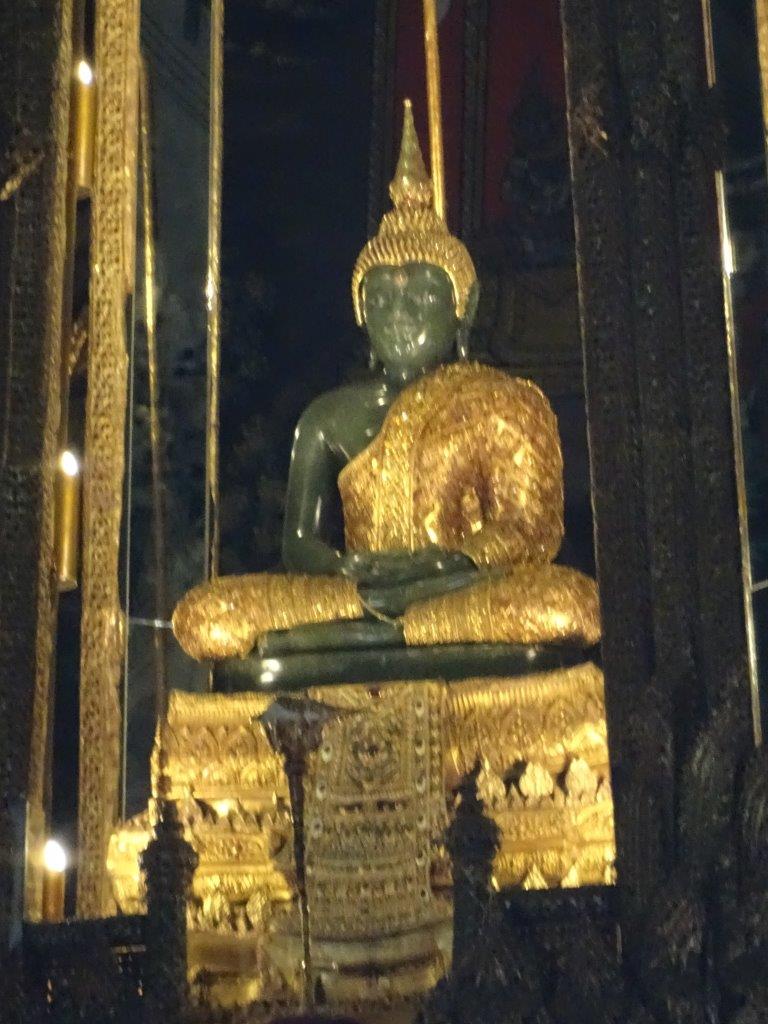
The King changes the cloak around the statue three times a year, corresponding to the summer, winter, and rainy seasons.
Okay you are done!
I’m only joking. Yes, it is a little underwhelming (the Buddha looks really small from the viewing area) but the true beauty is outside. Buddhist temples in Southeast Asia tend to follow two styles. The first is the simple kind typically seen in Singapore, Malaysia and Vietnam. The temples are whitewashed and plain to the eye. The temples in Thailand and Cambodia are more elaborate and in Thailand’s case very colourful and vibrant. This makes their temples very instagramable:
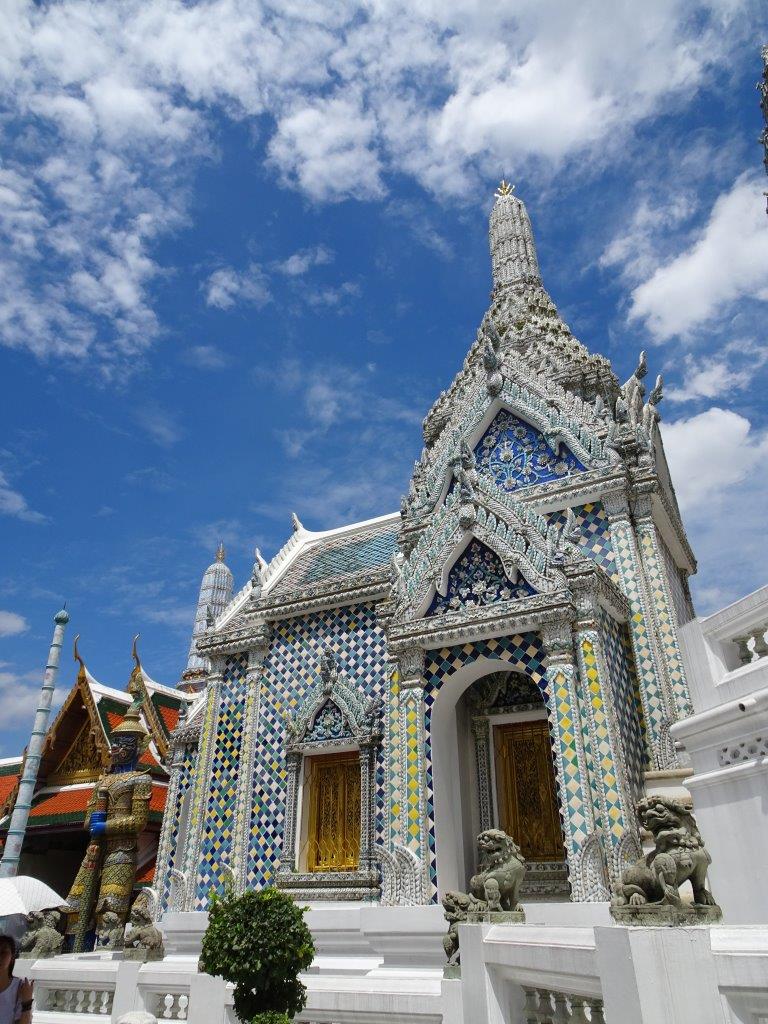

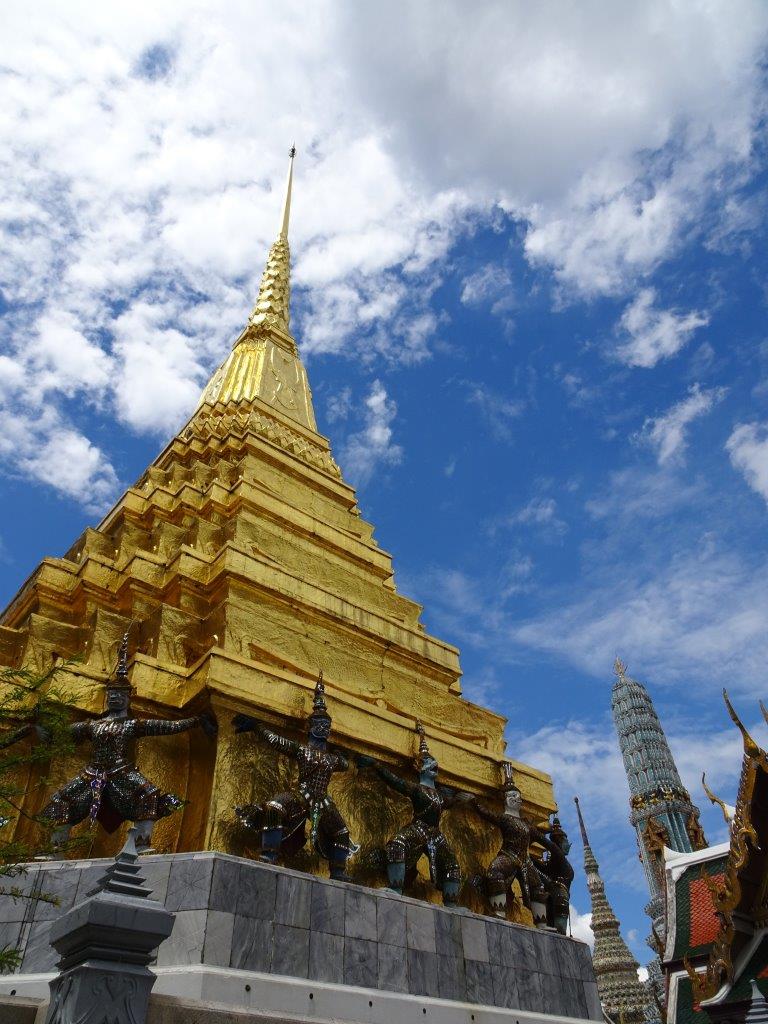
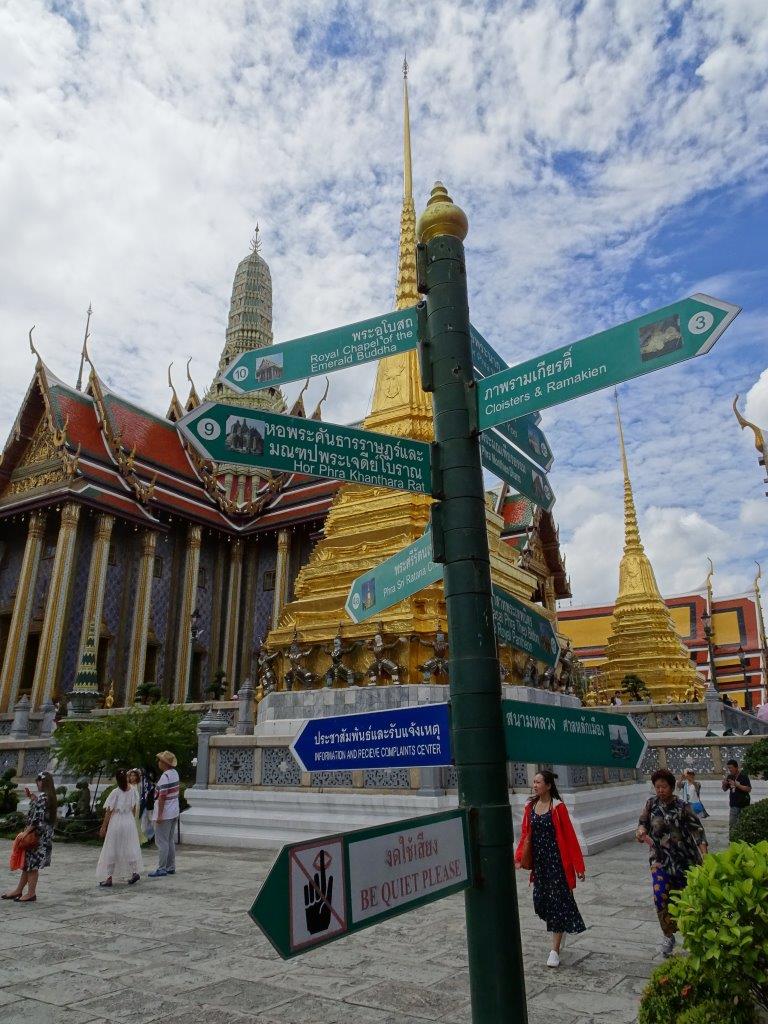

Once you are done with your photo taking (I sure took a lot) , you can head over to the Grand Palace area. While grand, it is largely closed off to the public. It still makes a good picture though:
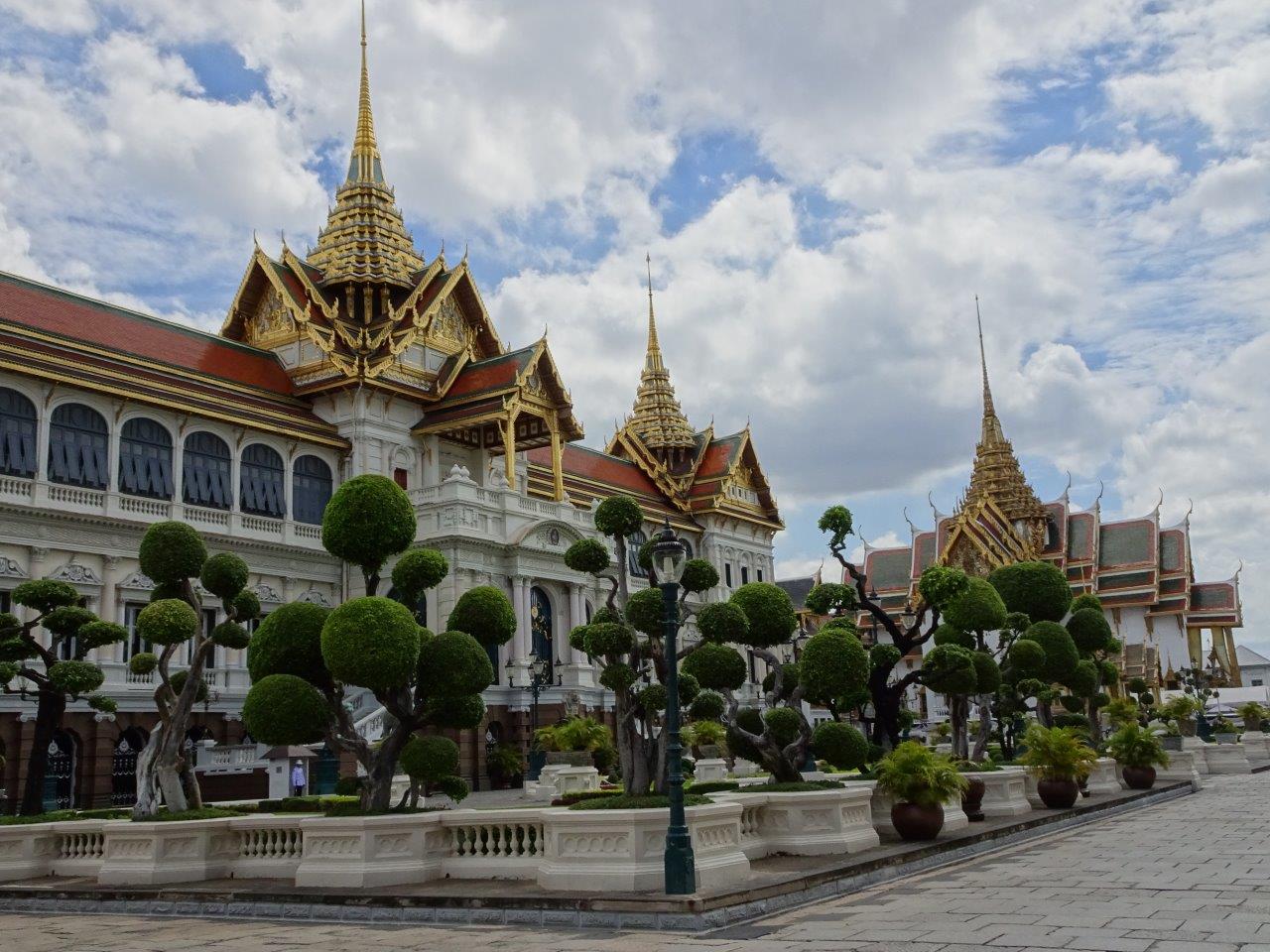
When you are done, leave by the main gate. If you are hungry, turn left. You will find a row of shops selling souvenirs and a few eateries. I popped into a beef noodles / rice place and got their No.1 recommended beef noodles. The broth was rich and flavourful with good chunks of beef in the bowl. For 60 Baht, it was a good bargain at a touristy spot like this. I topped it off with a nice ice cold cup of Thai Milk Tea. Yummmy!

Canal Boat Ride and Taling Chan floating market
When I was done with lunch, I decided to continue walking in the same direction thinking that it will lead me to some exit. I was definitely wrong this time as I was actually headed to the shoreline and I came across signs advertising boat rides.
I thought to myself that I had nothing to lose (other than the boat fare) to go for a boat ride. So I walked into the ferry terminal and approached the most obvious stall there (one directly facing the entrance and in front of the queues to the piers). I was offered an hour’s ride (no stopping) for 1000 Baht and a one and a half hour’s ride (with a stop at a floating market) for 1300 Baht. I went with the latter (again, why not since the price difference is minimal).
Caution: When I was preparing this review/guide, I realised that they may have been cheaper options available. So my readers, please ask around the pier area to see what better deals you can get for yourself. Just be mindful that while some deals might be very cheap, do consider the actual time you spend doing certain activities. For example there is no reason to pay 1000 Baht (just giving some random example) to visit 4 floating markets in 2 hours as you will be touching and going for each of these markets instead of spending quality time in a market (which should be the ideal situation).
Of the 1.5 hours, I had half an hour to tour Taling Chan floating market. It is a small floating market offering a range of items. The market can be split into two areas. One is by the shore and the other is onshore. The onshore part has at least 20 small stalls selling food items and other souvenirs. As I just had lunch, I wasn’t too hungry. I therefore went with something unique: Crispy Pancakes with some kind of cream of them topped with what appears to be coconut shavings. These pancakes were mixed and had savoury and sweet pancakes. Personally I preferred to savoury ones (those with the red coconut shavings and cilantro bits on them.
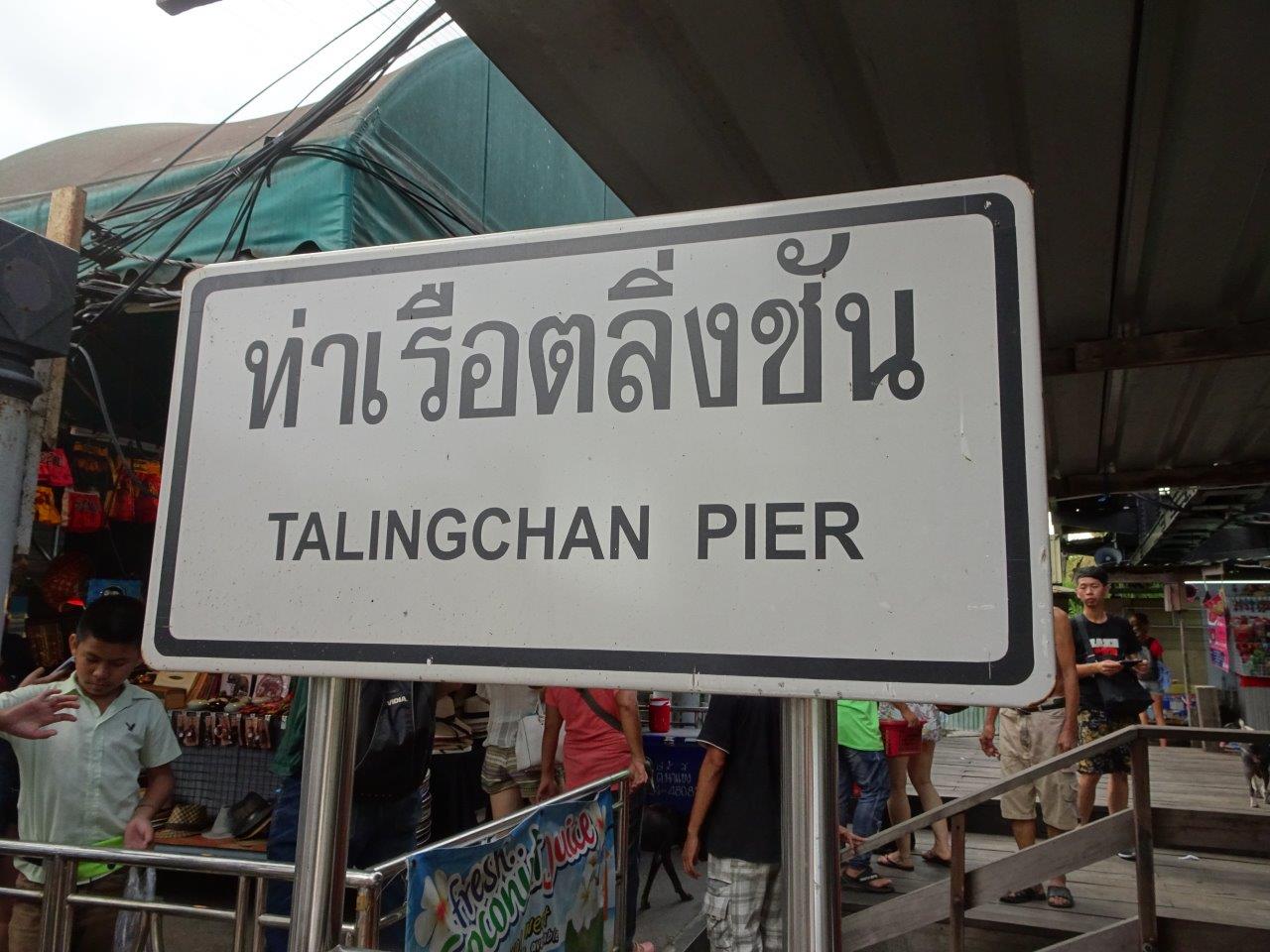
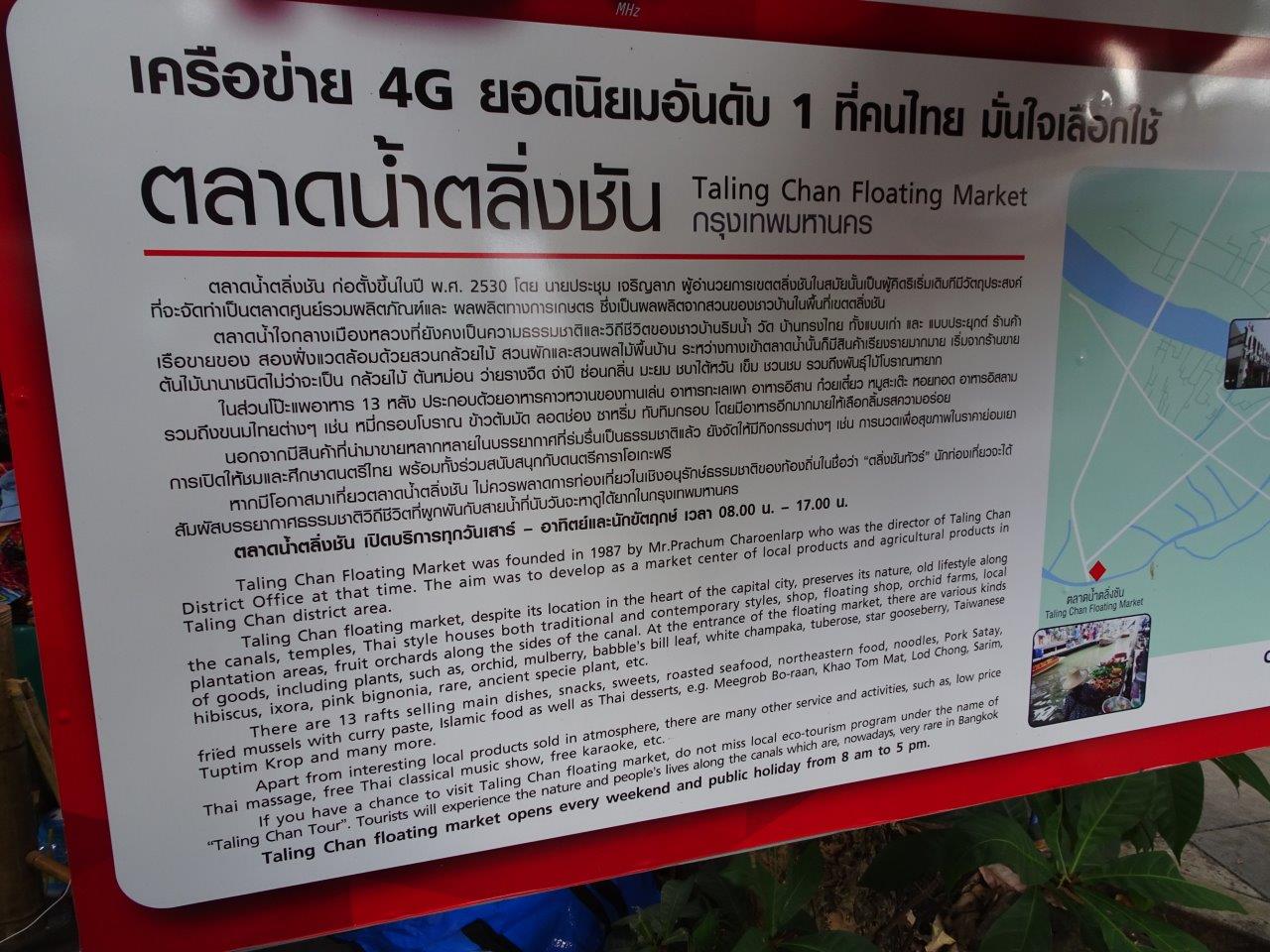
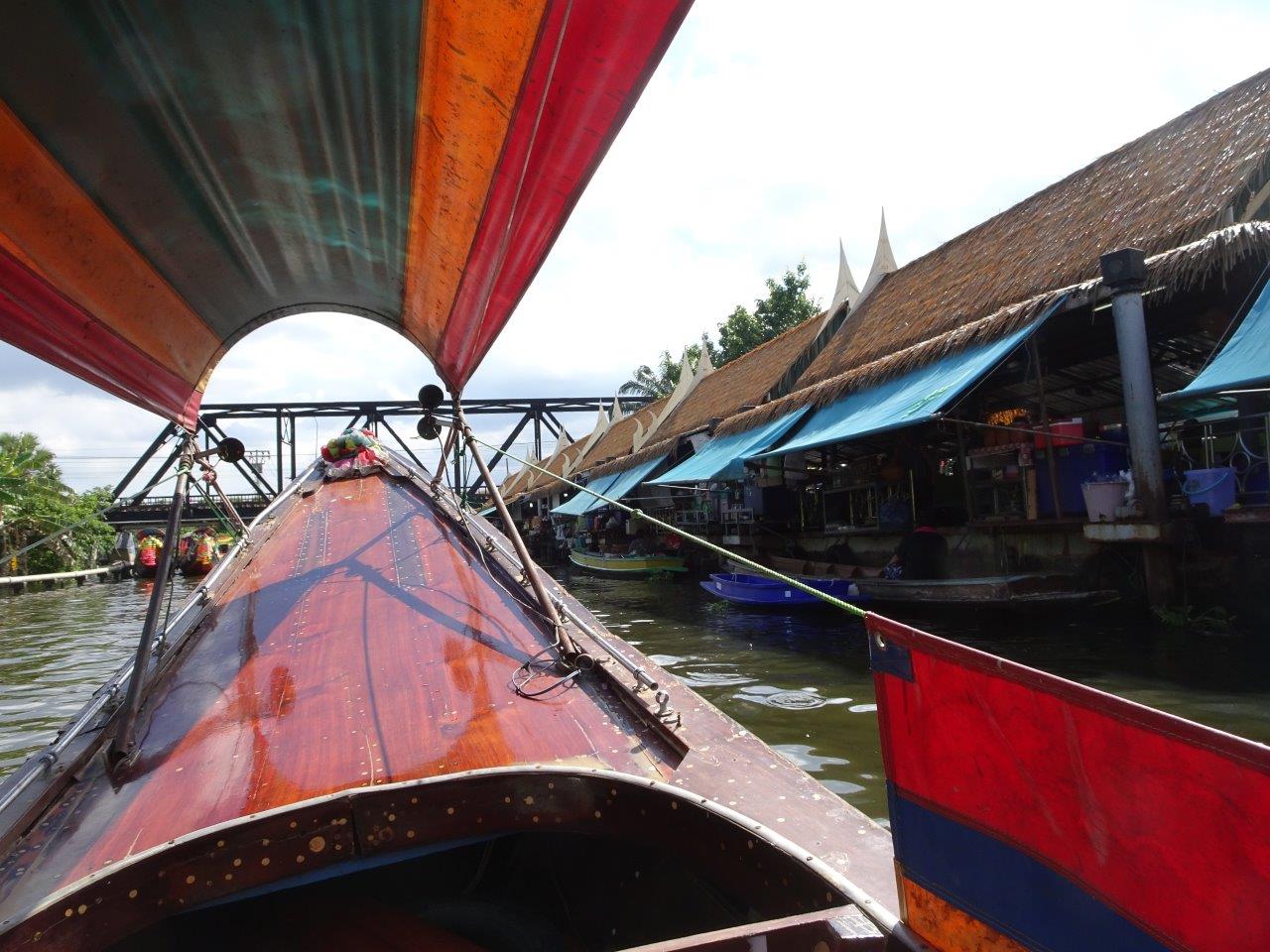
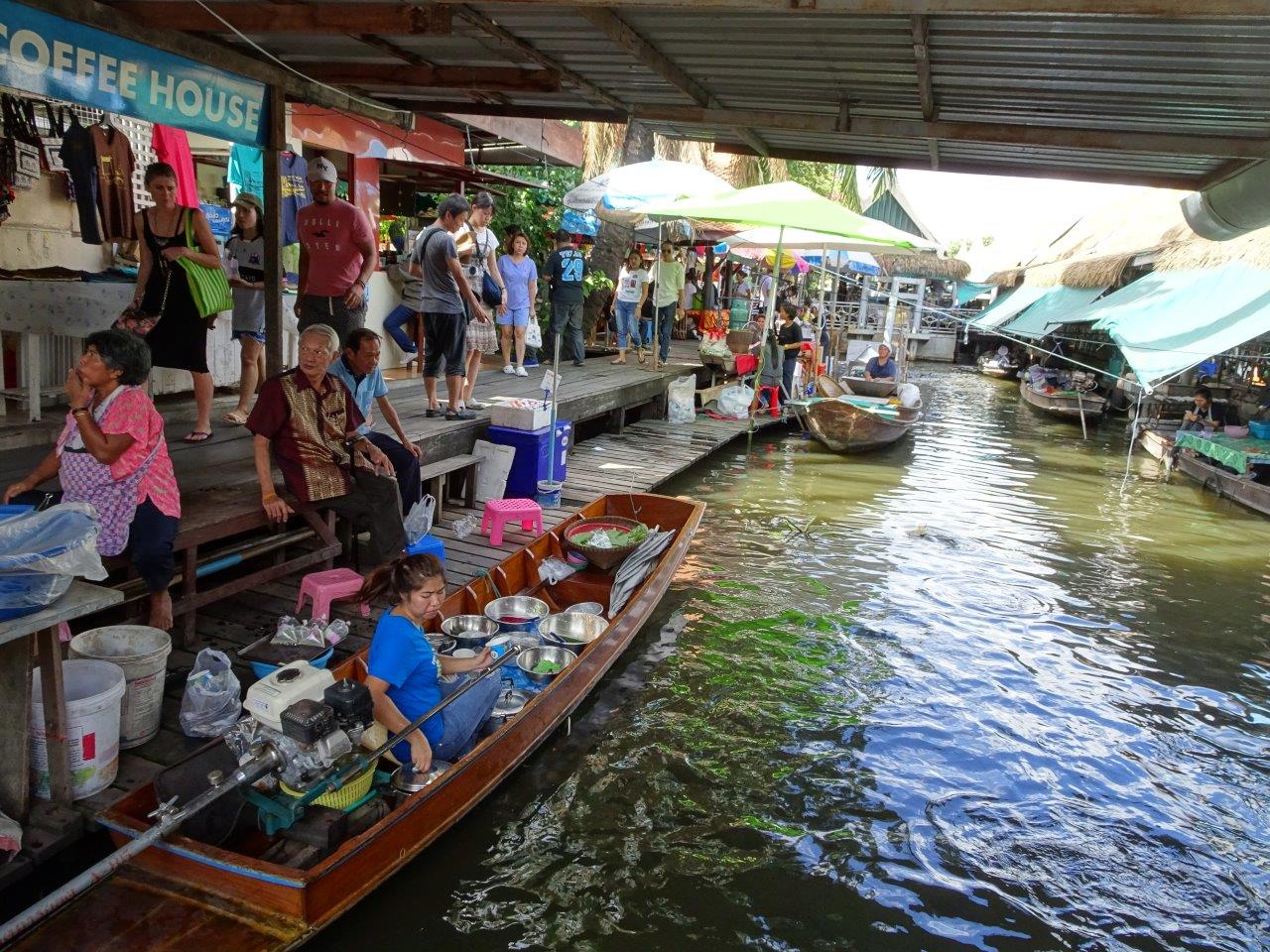
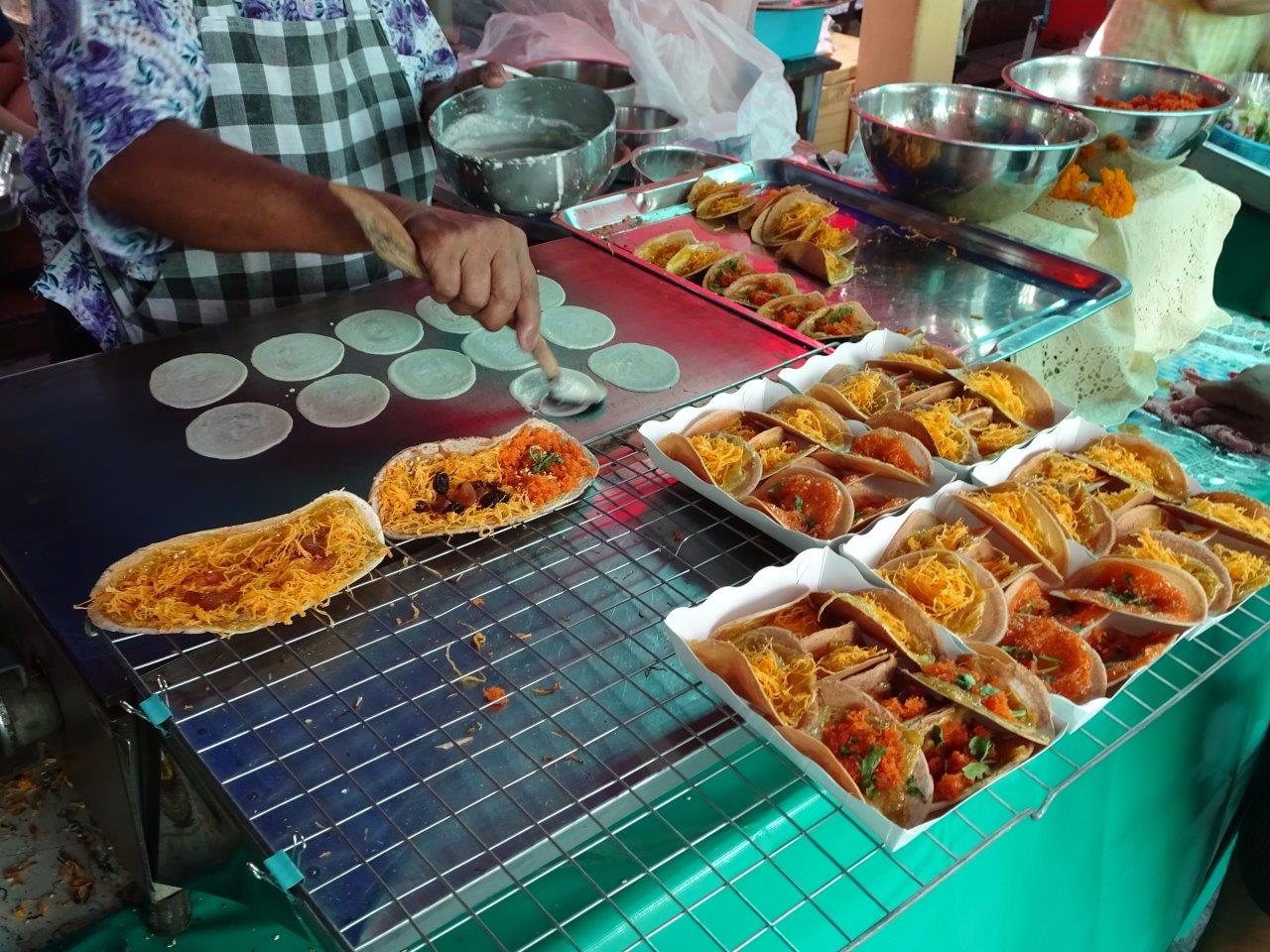
I carried my food to the music area which had a band playing. I got myself a small can of Chang beer before diving into my food:
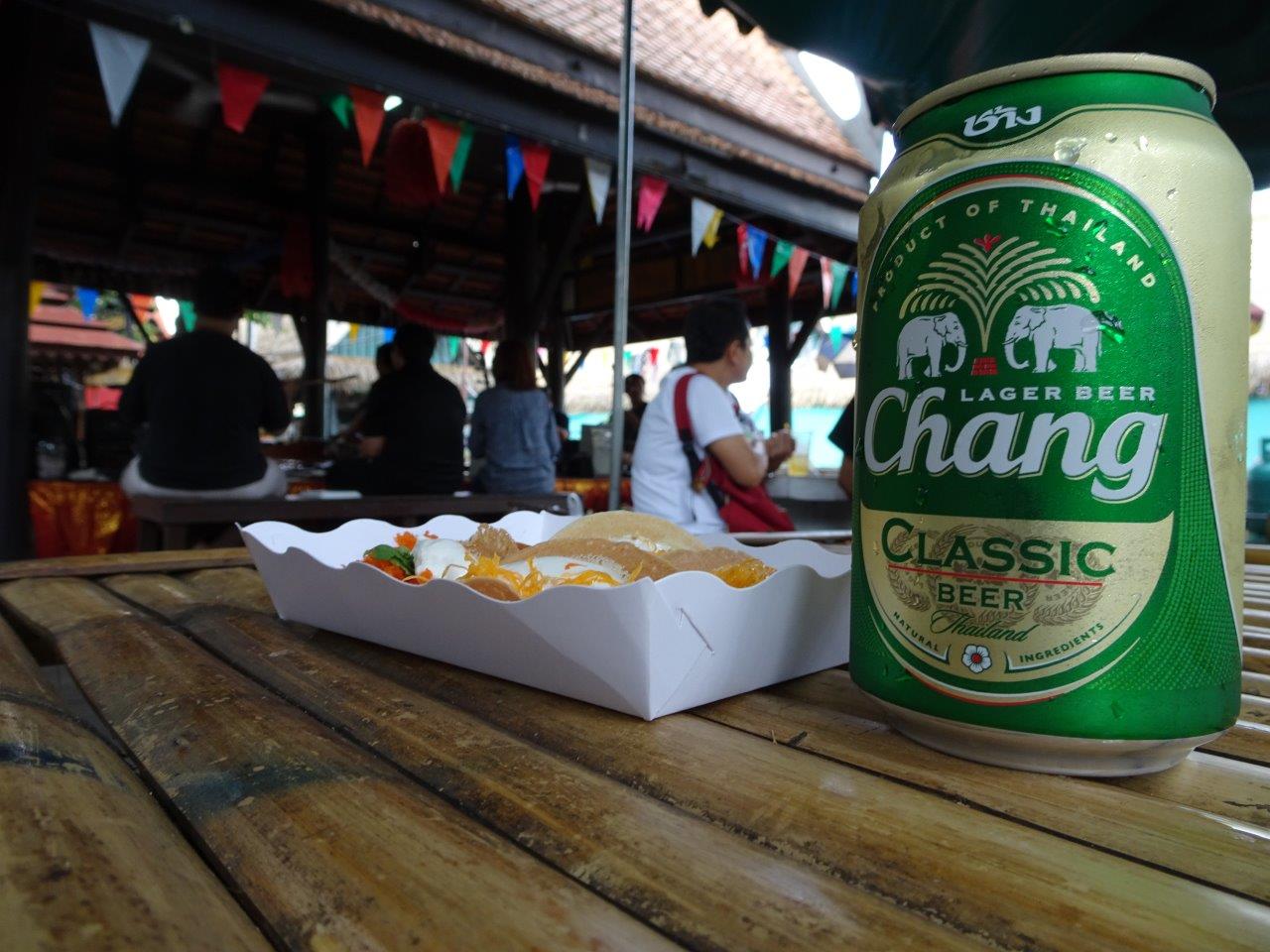
If you are hungrier, you can try to grab some seafood from the stalls by the shore. The stalls here are more of a hybrid. Instead of having to eat on a floating boat, the eating part is now done on raised platforms with tables set on them. The cooking, however, is still carried out on little boats docked against these platforms thus retaining some of that real floating market flavour.
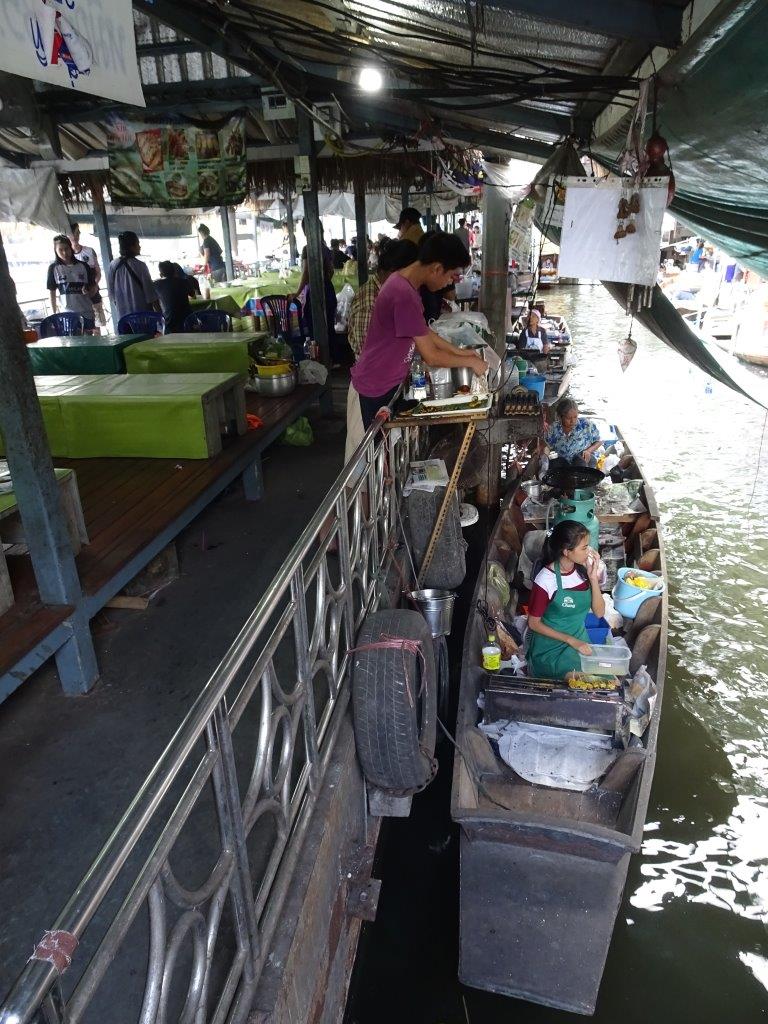
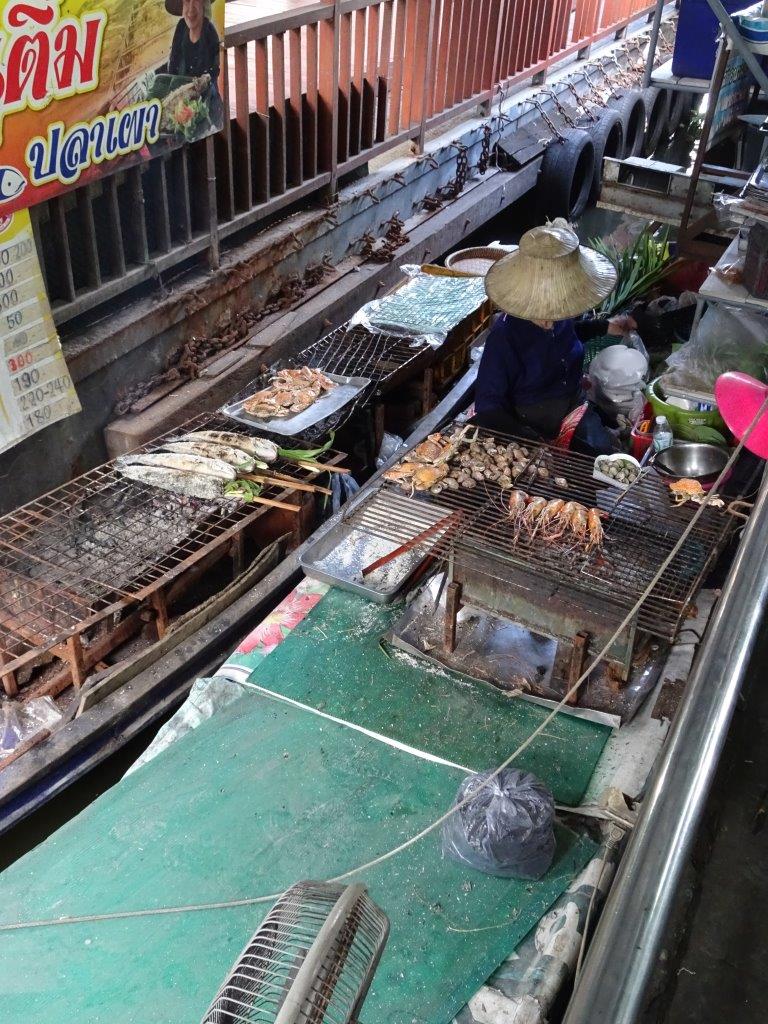
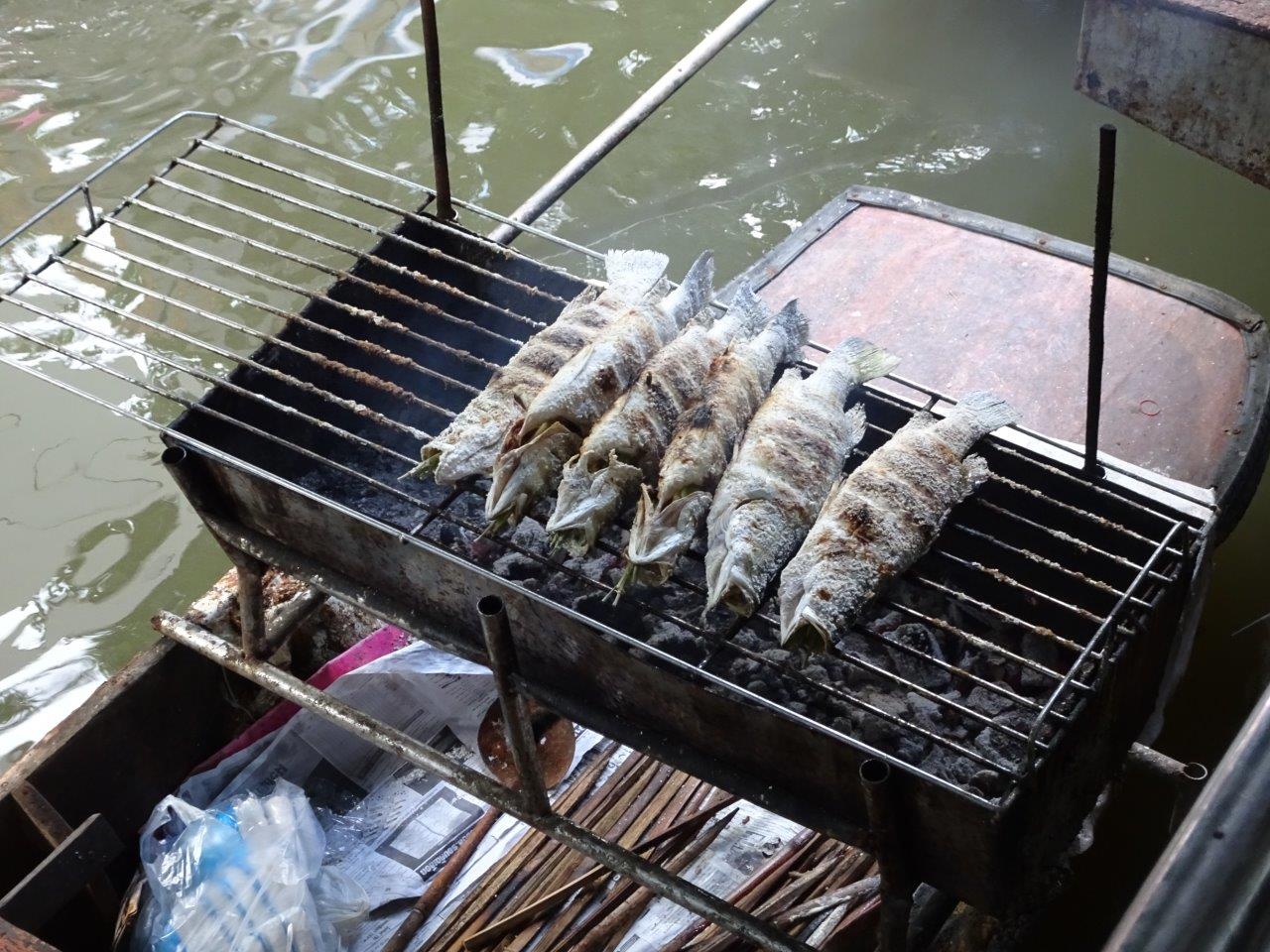
If food is not your thing, you can either grab a quick massage at the market or go grab awesome pictures of a train track. The floating market is located beneath a railway bridge that is actually operational (thank god there was no train when I was taking the pictures):
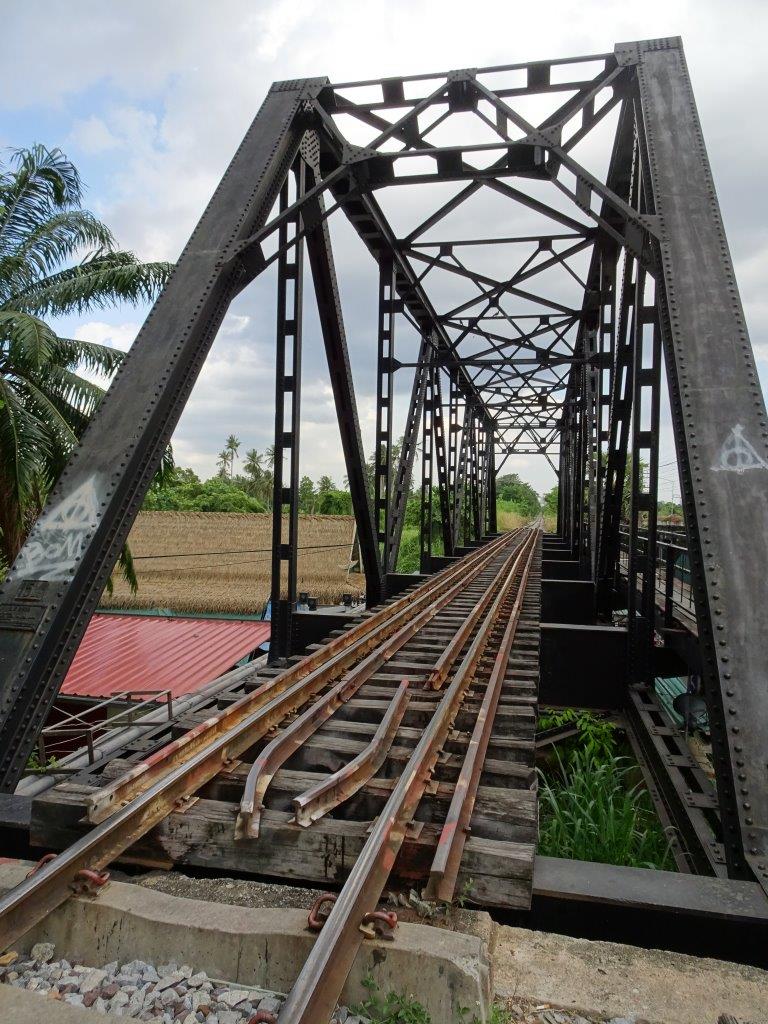
After visiting the market, it was back to the pier. The ride was enjoyable and was a good escape from Bangkok’s traffic congested roads. One plus point is that as you head deep into the canals, you get to see the less built up areas of Bangkok and another side of Bangkok.
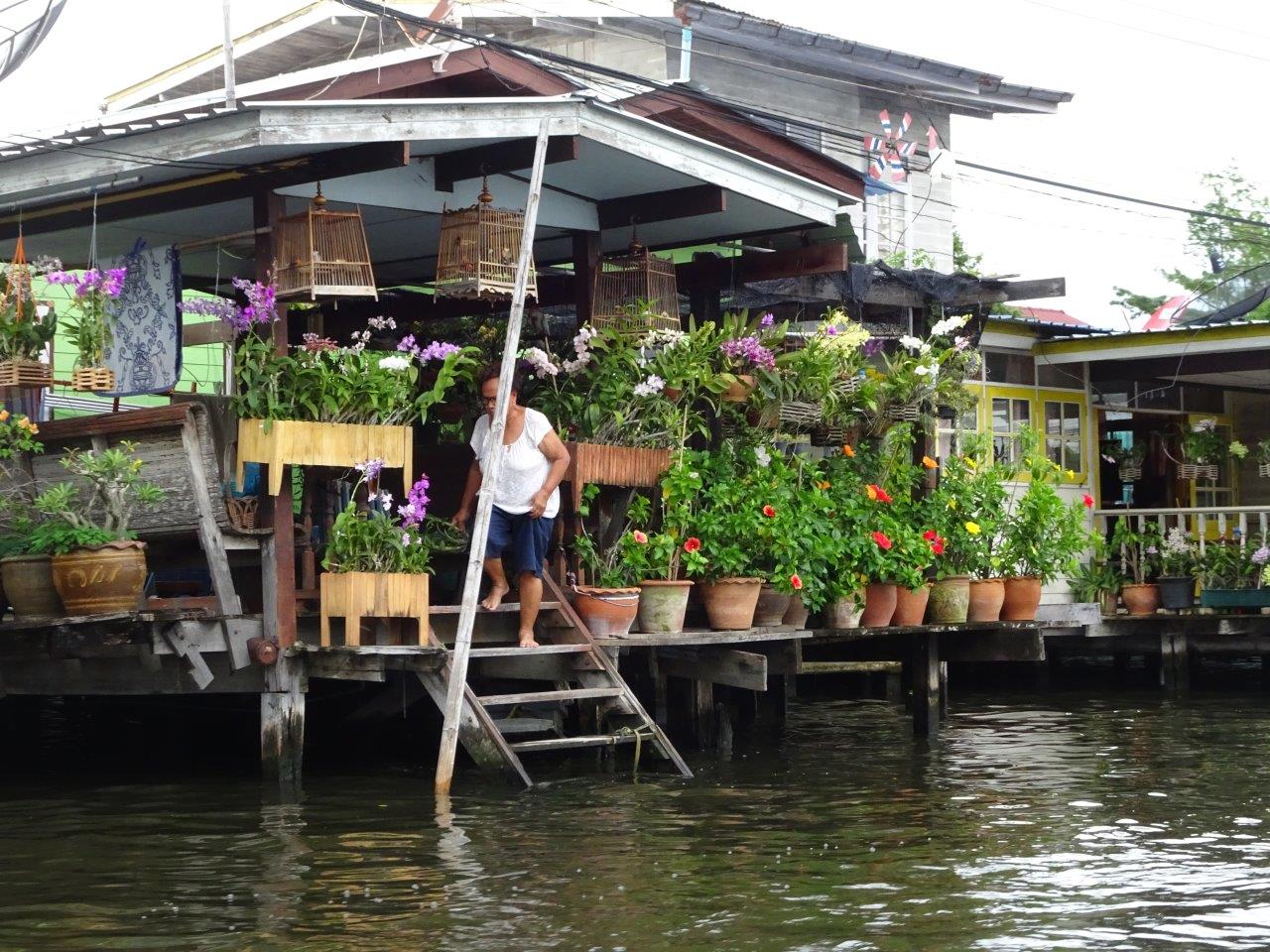

My boat brought be back to the area where I boarded near the Grand Palace. From the Grand Palace, there are a few ways to make your exit. You can either take a taxi or a Grab/Uber back to your hotel (which is very difficult as the drivers are unwilling to brave the notorious jams in Bangkok) or you can choose to ask them to drop you off at the nearest metro station (National Stadium) and taking the metro to where you are headed. I ended up doing the latter as I did not want to feel cheated by the drivers who were demanding 400-600 baht for a journey not more than 200 by meter.
I hope you found this guide helpful. If you enjoyed reading my work, please click like and please follow this blog for more awesome travel guides and reviews. Please also share with your friends.